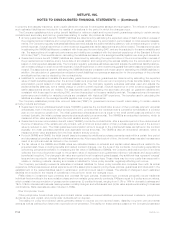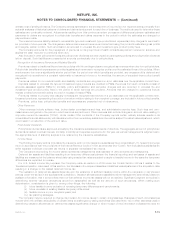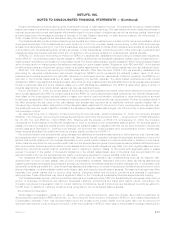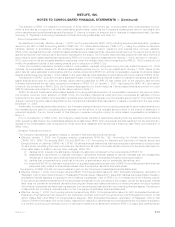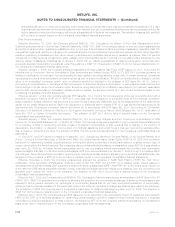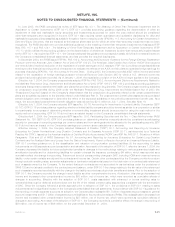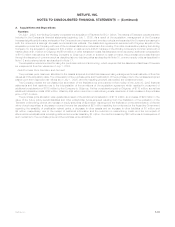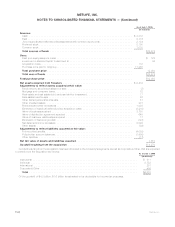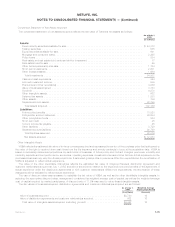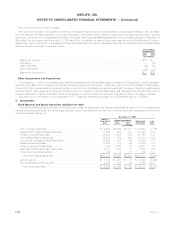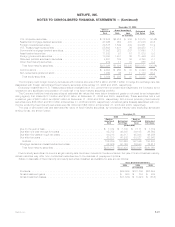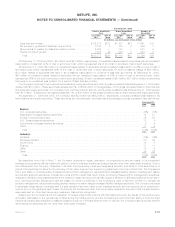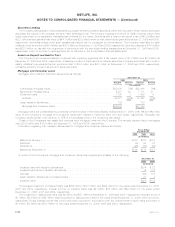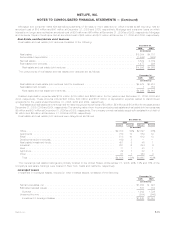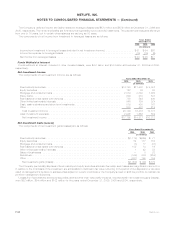MetLife 2006 Annual Report Download - page 105
Download and view the complete annual report
Please find page 105 of the 2006 MetLife annual report below. You can navigate through the pages in the report by either clicking on the pages listed below, or by using the keyword search tool below to find specific information within the annual report.Future Adoption of New Accounting Pronouncements
In February 2007, the FASB issued SFAS No. 159, the Fair Value Option for Financial Assets and Financial Liabilities (“SFAS 159”).
SFAS 159 permits all entities the option to measure most financial instruments and certain other items at fair value at specified election
dates and to report related unrealized gains and losses in earnings. The fair value option will generally be applied on an instrument-by-in-
strument basis and is generally an irrevocable election. SFAS 159 is effective for fiscal years beginning after November 15, 2007. The
Company is evaluating which eligible financial instruments, if any, it will elect to account for at fair value under SFAS 159 and the related
impact on the Company’s consolidated financial statements.
In December 2006, the FASB issued FSP EITF 00-19-2, Accounting for Registration Payment Arrangements (“FSP EITF 00-19-2”). FSP
EITF 00-19-2 specifies that the contingent obligation to make future payments or otherwise transfer consideration under a registration
payment arrangement should be separately recognized and measured in accordance with SFAS No. 5, Accounting for Contingencies. FSP
EITF 00-19-2 is effective immediately for registration payment arrangements and the financial instruments subject to those arrangements
that are entered into or modified subsequent to December 21, 2006. For registration payment arrangements and financial instruments
subject to those arrangements that were entered into prior to December 21, 2006, the guidance in the FSP is effective for fiscal years
beginning after December 15, 2006. The Company does not expect FSP EITF 00-19-2 to have a material impact on the Company’s
consolidated financial statements.
In September 2006, the FASB issued SFAS No. 157, Fair Value Measurements (“SFAS 157”). SFAS 157 defines fair value, establishes a
framework for measuring fair value in GAAP and requires enhanced disclosures about fair value measurements. SFAS 157 does not require
any new fair value measurements. The pronouncement is effective for fiscal years beginning after November 15, 2007. The guidance in
SFAS 157 will be applied prospectively with the exception of: (i) block discounts of financial instruments; and (ii) certain financial and hybrid
instruments measured at initial recognition under SFAS 133 which is to be applied retrospectively as of the beginning of initial adoption (a
limited form of retrospective application). The Company is currently evaluating the impact of SFAS 157 on the Company’s consolidated
financial statements. Implementation of SFAS 157 will require additional disclosures in the Company’s consolidated financial statements.
In July 2006, the FASB issued FSP No. FAS 13-2, Accounting for a Change or Projected Change in the Timing of Cash Flows Relating to
Income Taxes Generated by a Leveraged Lease Transaction (“FSP 13-2”). FSP 13-2 amends SFAS No. 13, Accounting for Leases,to
require that a lessor review the projected timing of income tax cash flows generated by a leveraged lease annually or more frequently if
events or circumstances indicate that a change in timing has occurred or is projected to occur. In addition, FSP 13-2 requires that the
change in the net investment balance resulting from the recalculation be recognized as a gain or loss from continuing operations in the
same line item in which leveraged lease income is recognized in the year in which the assumption is changed. The guidance in FSP 13-2 is
effective for fiscal years beginning after December 15, 2006. The Company does not expect FSP 13-2 to have a material impact on the
Company’s consolidated financial statements.
In June 2006, the FASB issued FIN No. 48, Accounting for Uncertainty in Income Taxes — an interpretation of FASB Statement No. 109
(“FIN 48”). FIN 48 clarifies the accounting for uncertainty in income tax recognized in a company’s financial statements. FIN 48 requires
companies to determine whether it is “more likely than not” that a tax position will be sustained upon examination by the appropriate taxing
authorities before any part of the benefit can be recorded in the financial statements. It also provides guidance on the recognition,
measurement and classification of income tax uncertainties, along with any related interest and penalties. Previously recorded income tax
benefits that no longer meet this standard are required to be charged to earnings in the period that such determination is made. FIN 48 will
also require significant additional disclosures. FIN 48 is effective for fiscal years beginning after December 15, 2006. Based upon the
Company’s evaluation work completed to date, the Company expects to recognize a reduction to the January 1, 2007 balance of retained
earnings of between $35 million and $60 million.
In March 2006, the FASB issued SFAS No. 156, Accounting for Servicing of Financial Assets — an amendment of FASB Statement
No. 140 (“SFAS 156”). Among other requirements, SFAS 156 requires an entity to recognize a servicing asset or servicing liability each time
it undertakes an obligation to service a financial asset by entering into a servicing contract in certain situations. SFAS 156 will be applied
prospectively and is effective for fiscal years beginning after September 15, 2006. The Company does not expect SFAS 156 to have a
material impact on the Company’s consolidated financial statements.
In September 2005, the AICPA issued SOP 05-1, Accounting by Insurance Enterprises for Deferred Acquisition Costs in Connection
with Modifications or Exchanges of Insurance Contracts (“SOP 05-1”). SOP 05-1 provides guidance on accounting by insurance
enterprises for DAC on internal replacements of insurance and investment contracts other than those specifically described in SFAS No. 97,
Accounting and Reporting by Insurance Enterprises for Certain Long-Duration Contracts and for Realized Gains and Losses from the Sale
of Investments. SOP 05-1 defines an internal replacement as a modification in product benefits, features, rights, or coverages that occurs
by the exchange of a contract for a new contract, or by amendment, endorsement, or rider to a contract, or by the election of a feature or
coverage within a contract. It is effective for internal replacements occurring in fiscal years beginning after December 15, 2006.
In addition, in February 2007 related TPAs were issued by the AICPA to provide further clarification of SOP 05-1. The TPAs are effective
concurrently with the adoption of the SOP. Based on the Company’s interpretation of SOP 05-1 and related TPAs, the adoption of SOP 05-1
will result in a reduction to DAC and VOBA relating primarily to the Company’s group life and health insurance contracts that contain certain
rate reset provisions. The Company estimates that the adoption of SOP 05-1 as of January 1, 2007 will result in a cumulative effect
adjustment of between $275 million and $310 million, net of income tax, which will be recorded as a reduction to retained earnings. In
addition, the Company estimates that accelerated DAC and VOBA amortization will reduce 2007 net income by approximately $25 million
to $35 million, net of income tax.
F-22 MetLife, Inc.
METLIFE, INC.
NOTES TO CONSOLIDATED FINANCIAL STATEMENTS — (Continued)




